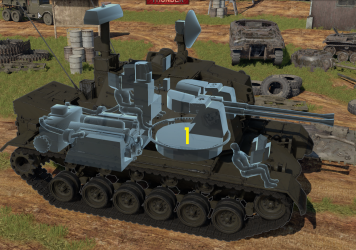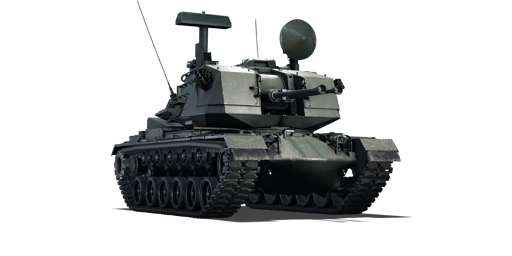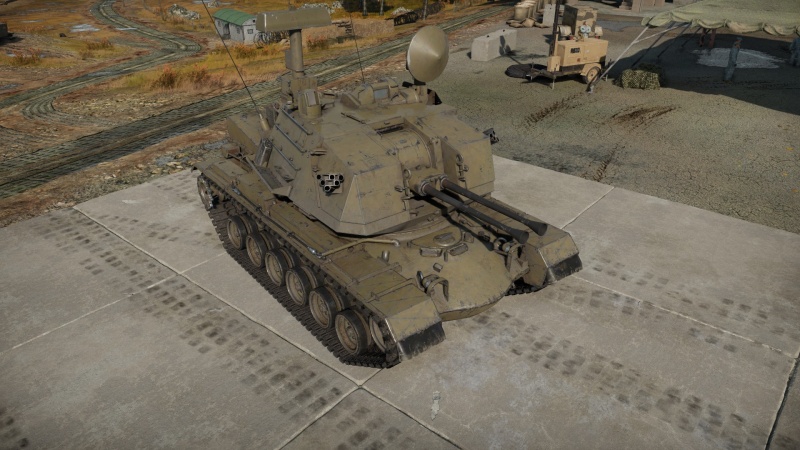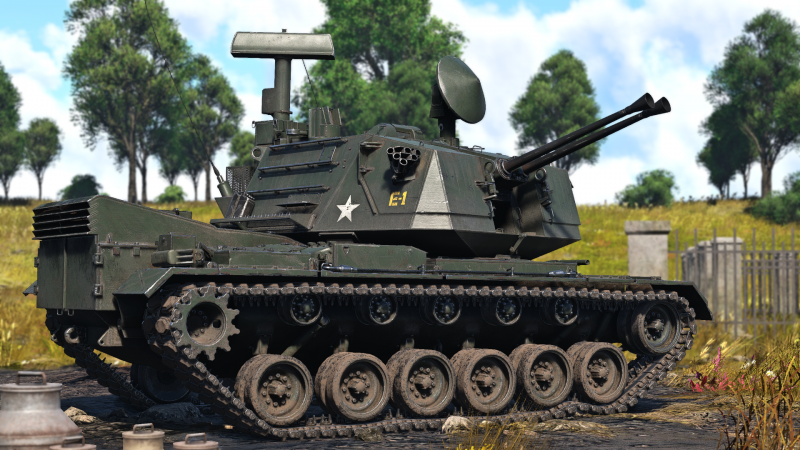M247
Contents
Description
The Gun, Air Defence Artillery, Self-Propelled, 40-mm, M247 is a rank VI American self-propelled anti-aircraft gun with a battle rating of 9.0 (AB/RB/SB). It was introduced in Update 1.81 "The Valkyries".
General info
Survivability and armour
Armour type:
- Cast homogeneous armour (hull)
- Rolled homogeneous armour (hull sides - rear bulge, hull roof, turret)
| Armour | Front (Slope angle) | Sides | Rear | Roof |
|---|---|---|---|---|
| Hull | 85-200 mm (59-74°) Front glacis 63-200 mm (13-60°) Lower glacis |
76 mm (8-43°) Front 51 mm (0-43°) Rear |
35 mm (26-32°) Top 25 mm (61-62°) Bottom |
57 mm |
| Turret | 25.4 mm (15-76°) Turret front (Upper) 12.7 mm (40-69°) Turret front (Lower) 25.4 mm (0-87°) Gun mantlet |
12.7-25.4 mm (0-19°) Upper 12.7 mm (40-69°) Lower |
12.7 mm (18°) | 12.7 mm |
Notes:
- Suspension wheels and tracks are 20 mm thick.
- Belly armour is 38 mm thick in the front half and 25 mm in the rear.
Mobility
| Game Mode | Max Speed (km/h) | Weight (tons) | Engine power (horsepower) | Power-to-weight ratio (hp/ton) | |||
|---|---|---|---|---|---|---|---|
| Forward | Reverse | Stock | Upgraded | Stock | Upgraded | ||
| Arcade | 52 | 13 | 54.4 | 1,065 | 1,431 | 19.58 | 26.31 |
| Realistic | 48 | 12 | 663 | 750 | 12.19 | 13.79 | |
The M247's turret is installed on the hull of an M48 medium tank, because of this they have roughly similar mobility. The M247 is about 3 tons heavier than the M48A1 (49.3 tons vs. 46.4 tons), and has a slightly weaker engine, which translates into a slightly more sluggish machine compared to the M48A1. The M48A1 has a max engine power of 810 hp, while the M247's engine power is 750 hp. For a vehicle this heavy, it has fairly good mobility. When spaded, it can comfortably hit a top speed of 45 km/h on flat terrain, while in cross-country you will have a top speed of around 25 km/h. While going backwards, the top speed is somewhat less impressive: about -9 km/h.
Modifications and economy
Armaments
Main armament
| 40 mm M266 automatic Cannon (x2) | Turret rotation speed (°/s) | Reloading rate (seconds) | ||||||||||||
|---|---|---|---|---|---|---|---|---|---|---|---|---|---|---|
| Mode | Capacity (Belt) | Fire rate | Vertical | Horizontal | Stabilizer | Stock | Upgraded | Full | Expert | Aced | Stock | Full | Expert | Aced |
| Arcade | 560 (280) | 300 | -10°/+85° | ±180° | Two-plane | 79.2 | 109.7 | 133.2 | 147.3 | 156.7 | 6.50 | 5.75 | 5.30 | 5.00 |
| Realistic | 53.6 | 63.0 | 76.5 | 84.6 | 90.0 | |||||||||
Ammunition
- Default: SAPHEI · HEF-I*
- M811 Fuze Delay: SAPHEI
- M811: HEF-I* - Unlike the M822 HE-VT* shells, these require direct hits on aircraft to do significant damage, but if problems are experienced with M822 detonating too early this belt may be your best choice.
- M822: HE-VT* - Proximity-fused shells that absolutely obliterate aircraft when they make contact, though if they detonate too early, they will do little to no damage. Somewhat unreliable in if they detonate within range of the target, but when they do the target will quickly take considerable damage if not destroyed. The only ammunition for self-propelled anti-aircraft guns that which can cause enough shrapnel damage to bring down planes and helicopters even with near misses. This round should be the go-to anti-air ammunition, although the M811 is a good backup if the M822 is problematic for the gunner.
| Penetration statistics | |||||||
|---|---|---|---|---|---|---|---|
| Ammunition | Type of warhead |
Penetration @ 0° Angle of Attack (mm) | |||||
| 10 m | 100 m | 500 m | 1,000 m | 1,500 m | 2,000 m | ||
| M811 Fuze Delay | SAPHEI | 38 | 36 | 30 | 24 | 19 | 15 |
| M811 | HEF-I* | 6 | 6 | 6 | 6 | 6 | 6 |
| M822 | HE-VT* | 5 | 5 | 5 | 5 | 5 | 5 |
| Shell details | |||||||||
|---|---|---|---|---|---|---|---|---|---|
| Ammunition | Type of warhead |
Velocity (m/s) |
Projectile Mass (kg) |
Fuse delay (m) |
Fuse sensitivity (mm) |
Explosive Mass (TNT equivalent) (g) |
Ricochet | ||
| 0% | 50% | 100% | |||||||
| M811 Fuze Delay | SAPHEI | 1,100 | 0.86 | 1.2 | 9 | 262 | 79° | 80° | 81° |
| M811 | HEF-I* | 1,100 | 0.86 | 0 | 0.1 | 262 | 79° | 80° | 81° |
| Shell details | |||||||||||
|---|---|---|---|---|---|---|---|---|---|---|---|
| Ammunition | Type of warhead |
Velocity (m/s) |
Projectile Mass (kg) |
Fuse delay (m) |
Fuse sensitivity (mm) |
Explosive Mass (TNT equivalent) (g) |
Arming distance (m) |
Trigger radius (m) |
Ricochet | ||
| 0% | 50% | 100% | |||||||||
| M822 | HE-VT* | 1,100 | 0.86 | 0 | 0.1 | 191 | 500 | 4 | 79° | 80° | 81° |
Ammo racks

| Full ammo |
1st rack empty |
Visual discrepancy |
|---|---|---|
| 1 | 0 (+1) | No |
Notes:
- With a single ammunition rack, you can bring only 1 type of ammunition in battle.
Usage in battles
The M247 Sgt York is a very deadly SPAA, The M247 is deadly to some lightly armoured vehicles but even deadlier to Aircraft. When using the M247 you can easily shred some lightly armoured vehicles like the Leopard 1. Where the speciality for the M247 is with its Proximity fused 40 mm rounds. They will shred any aircraft within a 2.0 km radius. You can play the vehicle mostly in 2 ways. You can push and try defending caps from the enemies and keeping the skies clear, or stay back behind cover and keep the skies clear for your allies, while using your AP rounds to fend off enemy vehicles.
Generally, enemy tanks should be avoided - especially from the front - but in desperate times or the right circumstances many of them can be dealt with. Due to the decent armour-piercing ammunition used by the M247, most tanks at its BR can be penetrated from the side. Common examples of tanks that are easy to penetrate from the side are the Leopard 1 and OF-40 families. Soviet tanks are quite a bit harder to penetrate and may not be penetrated except when nearly perpendicular to your guns. All light tanks and SPAAs can be penetrated from the side and many of them from the front as well. Again, full sized tanks should not generally be engaged except when there is no other choice, in which case aiming for the gun barrel may be the best choice, except when engaged from the side. Light vehicles, on the other hand, can be engaged favorably in most circumstances.
Ammunition
The recommended ammunition belt is the M822 belt, which includes both the AP and HE-VT rounds.
This belt is the best at taking out enemy aircraft because the proximity fuze rounds make it so that a direct hit on an aircraft is not needed, the shells must only pass near the aircraft to damage it. This belt also includes armour-piercing rounds so that if a ground target is spotted it can be engaged when necessary. The AP rounds have enough penetration (94 mm maximum) to go through the fronts of many light tanks and SPAA vehicles, as well as the sides of most other vehicles including main battle tanks (MBTs). The only class of vehicles that can not be penetrated in a majority of cases is the heavy tank class, which should be avoided as much as possible.
Pros and cons
Pros:
- Has access to 12 smoke grenades
- The hull has adequate protection against most light tank calibre rounds
- Can retract and extend both search and tracking radars to reduce silhouette
- Twin stabilized 40 mm cannons have a high rate of fire
- Large ammunition count ensures that you will have plenty to fire throughout a match
- Potent proximity ammunition for anti-aircraft use
- The HE-VT belt has no tracers making it near impossible for enemy aircraft to see and doge the incoming shells
- Radar allows for high range of detection and very accurate tracking, with 10 km tracking and 40 km detection range
- Has access to night vision devices, a laser rangefinder, commander sights, and commander fire control
Cons:
- Vulnerable to enemy armour, artillery strikes and air attacks
- The turret armour is only 5 mm thick, which is easy to penetrate even for rifle-calibre MGs
- Only three crew members
- Radar is tall and can expose your position
- The M247 is sluggish especially when stock, will usually not be able to keep up with MBTs
- The high rate of fire can deplete the ammo quickly without proper trigger discipline
- HE-VT belt is only available at tier IV
- Completely lacks any armor-piercing shells in any belts, giving it very poor defensive capabilities against ground vehicles, even lightly armored ones
- The gunner sight optics only has one zoom setting (12.0x with a sight FOV of 6) meaning that you may struggle to engage tanks and to lock/eliminate aircraft
- 5-minute long restock time on a capture point after depleting ammo
- No IRST mode and cannot lock onto targets when the radar is off
- Using the laser rangefinder does not adjust the range of the guns
History
The M247 "Sergeant York" was designed in the late 1970's as a purpose-built SPAAG. It was designed to fight alongside the M1 Abrams and M2/M3 Bradley, in order to provide cover against aircraft. There were other SPAA vehicles in service at the time; these were the M163 Vulcan and the MIM-72/M48 Chaparral. The former being a 20 mm rotary cannon mounted on an armoured personnel carrier, and the latter being a heavily modified armoured personnel carrier chassis with a surface-to-air missile launcher. Neither of those two vehicles were designed as SPAA's, and so, did not have the necessary performance to be adequate at their job. The M247 was designed as a replacement for both of the previous vehicles.
Designs from a multitude of companies were entered into the competition. Only two were selected for testing: the Ford XM-247 with twin Bofors 40 mm cannons and the General Dynamics XM-246 with twin Oerlikon 35 mm cannons. The two prototypes were tested, and the XM-247 was selected as the winner, although the XM-246 had outscored it in all the shooting tests. The M247, as it was soon designated, ran into many problems. The radar was extremely deficient; it had a hard time distinguishing trees from planes, and if the guns were pointed too high, they would get in the radar's way and confuse it even more. In addition, it took too long for the radar to pick up a target and for the guns to actually take aim. In addition, the turret traverse speed was much too slow, the vehicle it's self was too sluggish to keep up the M1's and M2's, and it was unreliable in cold weather. Eventually, the program was cancelled after more testing, where it was proven the system could not even shoot down stationary drones. There was still a need for an anti-aircraft vehicle that could keep up with modern vehicles, so Oerlikon Canada created the ADATS anti-aircraft missile system. This was not as successful as hoped, and was only accepted into Canadian service. The void was eventually filled by the M6 Linebacker, an M2 Bradley with Stinger missiles instead of TOW missiles. The Linebacker was capable of keeping up with modern armoured forces, which was the reason for its acceptance, even though the Stingers were not as effective as the ADATS missiles[1].
Media
- Skins
See also
- Vehicles equipped with the same chassis
- Other vehicles of similar configuration and role
External links
- [Devblog] TAM and M247 Sergeant York
- [Wikipedia] M247 Sergeant York
- [Military Factory] M247 Sergeant York
References
| Ford Motor Company | |
|---|---|
| Armoured cars | M8 Greyhound |
| SPAAGs | M247 Sergeant York |
| Export | ␗M8 LAC |
| USA anti-aircraft vehicles | |
|---|---|
| M3 Half-track derivatives | M13 MGMC · M15 CGMC · M16 MGMC |
| M24 derivative | M19A1 |
| M41 derivative | M42 |
| Radar SPAAG | M163 · M247 |
| Missile SPAA | ADATS · Imp.Chaparral · LAV-AD · XM975 |






